|
FAQs about Poritid Coral
Identification
Related Articles: Poritid
Corals,
Related FAQs: Poritids
1, Poritids 2, Poritids 3, Poritid Behavior, Poritid Compatibility, Poritid Selection, Poritid Systems, Poritid Feeding, Poritid Health, Poritid Reproduction/Propagation,
Stony/True Coral, Coral System Set-Up, Coral System Lighting, Stony Coral Identification, Stony Coral Selection, Coral Placement, Foods/Feeding/Nutrition, Disease/Health, Propagation, Growing Reef Corals, Stony Coral Behavior,
|
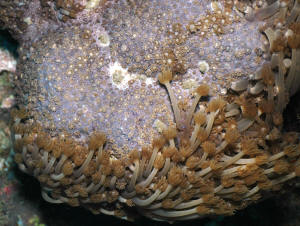
|
|
Goniopora ID 3/8/2011
Hello,
<Hello Orestes>
As always, I hope all is going well.
<Tis>
I bought this little guy from a LFS. They just sold it as a goni.
I wanted to know if you could tell me what type it is?
<Have you looked/searched here?
http://www.wetwebmedia.com/gonioporapix.htm
Judging by the photo, it doesn't appear you have enough light
intensity to keep this coral.>
Thanks
<You're welcome. James (Salty Dog)>
|
|
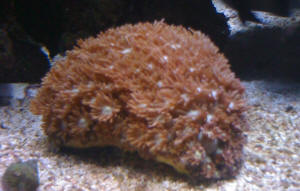
|
Re: Mushroom ID 10/27/09
Here's another one. A hard coral this time.
Regards
Beta
<Interesting... the first pic looks like an Oculinid/Galaxea
sp., but in viewing the second image, what appeared to be skeletal
elements are tentacles... Likely a Poritid/Goniopora sp.
BobF> |
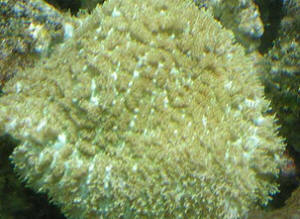 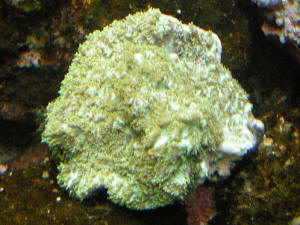 |
|
LPS ID and phytoplankton product use
-- 10/26/09
Hi Grew,
I'm one more person, who would like to say how great and
informative your site.
<We share!>
I'm new in the hobby. My tank is 6 mo, however thanks to all
your advices, everything is doing well. I read your articles
almost every day.
I have a question regarding LPS ID. I found it in one local fish
store under name Neon Green. A salesman could not give me any
additional info. It covers a life rock, polyps a small about 3 mm
in diameter and 2-3 mm tall. They retract when disturbed. Is it
kind of Turbinaria?
<Mmm, need either better vision (no doubt actually) or a bit
larger, more-resolved image here, but I am pretty sure this is a
Goniopora (commonly called "Flowerpot") coral. Please
see here: http://wetwebmedia.com/gonioporapix.htm
and the linked files above re this genus' care>
And one more question. In most of your articles you mentioned
that corals eat zoo-plankton.
<Most all do to extents... along with no to some variable
amount of photosynthesis>
What kind of coral eat phytoplankton?
<... actually very few of what passes as "corals",
definitely not Scleractinians/Stonies consume much of any
phyto>
An instruction on bottles with phytoplankton says, that it is
food for filter feeders and corals.
<... A good point, statement... Most all such material is of
limited (to the extreme) use in hobbyist systems. The bulk is
taken out via skimming... Some soft coral groups (Alcyonaceans)
consume "some" species, sizes of phytoplankton... and
adding such products can lead indirectly to "better
conditions" in captive systems... but most of it is a
placebo>
Thank you for you time.
Igor
<And you for sharing. Bob Fenner>
|
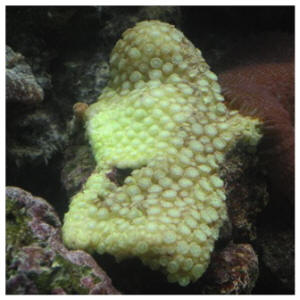 |
|
Re: LPS ID 10/27/09
Bob,
Thank you very much. That is what I did not like to hear. I read
that Goniopora sp is difficult one.
Here is one more image. I hope this resolution is better.
Best regards,
Igor
<I do think this is a Goniopora further still. B>
|
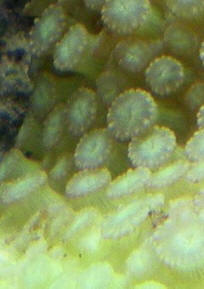 |
Flowerpot, Poritid ID, care 8/25/09
Hi Crew,
<Hey Sam, long time no hear.>
I saw a nice coral in my local LFS and they said it was a flowerpot. Is
there any easy way for me to tell if it is Alveopora or Goniopora.
<Alveopora has 12 tentacles per polyp whereas Goniopora have 24.
Should be easy enough, but knowing your system by heart, I don't
think your lighting is capable of supporting either of the two.>
At the time I did not know enough to ask the question but after reading
it seems people call both flowerpots but one seems to be impossible to
keep. I guess I could ask them but sometimes I wonder if they really
know.
Thanks
<You're welcome. James (Salty Dog)>
Re Flowerpot, Poritid care 8/26/09
Hi James,
<Sam>
You comment about lighting surprises me. Based on what I read recently
( I can't find it right now) Mr Fenner writes that Alveopora
problems come from either too clean water or too much light. So my
impression is my 65w PC should be ok.
<I believe what Mr. Fenner was alluding to in "too much
light", is in the form of high wattage MH lighting. In your tank,
24 gallon, if my memory serves me right, you would need a 150 watt HQI
lamp or two 65 watt PC's to provide acceptable light requirements
for this coral. Most LPS corals are going to require moderate
to strong lighting to survive.
Although not quite as delicate as Goniopora, Alveopora is still a
difficult coral to keep for any length of time. At Waikiki Aquarium in
Hawaii, they have been able to sustain Alveopora for over a decade and
a half by providing the coral with natural sunlight and a constant flow
of ocean water. James (Salty Dog)>
Re Flowerpot 8/26/09
Thanks,
You just save me a few bucks and some frustration.
<You're welcome, Sam. James (Salty Dog)>
Sam
|
Trying to identify a coral hitchhiker
7/23/09
Hi Crew,
It's been a long time since I've had to ask you guys and
gals a question. This is actually the first question I've had
since setting up a reef tank that I haven't been able to
answer by reading the articles and FAQs on WWM.
I have been trying to identify a stony coral hitchhiker that came
in on a rock I purchased at my local fish store. I purchased the
rock for the blue clove polyps, but I definitely got more than I
paid for. I have spent the last week searching WWM until my eyes
hurt. I have no idea where on earth the rock came from
originally, which makes it even harder to figure out what this
coral is. One ocean worth of species to search through is
difficult enough; trying to identify something that may have come
from anywhere tropical on earth is exhausting.
Anyway, here's what I do know about the coral: It is
definitely stony, it has polyps that extend well beyond the
skeleton when it is open, and it is growing like a weed. The
entire colony is about 1 inch by ½ inch currently, and
the polyps are tiny- a millimeter or two across at most. The
individual polyps have visible tentacles on them much like
Poritidae and Siderastreidae.
<Is a Poritid I'm pretty sure... of the genus Goniopora;
http://wetwebmedia.com/gonioporapix.htm>
Since a written description will only get you so far, and a
picture is worth a thousand words, I am attaching a couple of the
best pictures I could manage. I apologize in advance for the
large file sizes.
Thanks in advance for your time and efforts, even if this coral
remains unidentified.
Sean
<Thank you for writing so well, completely and clearly Sean.
Bob Fenner>
|
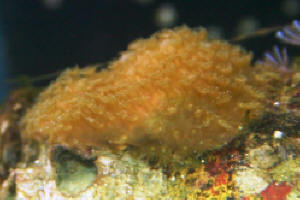 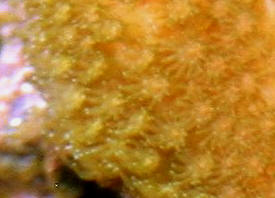 |
|
Re: Trying to identify a coral
hitchhiker 7/24/09
Bob,
Thanks for the quick response and the ID. I was afraid you were
going to say it was Goniopora. This is one coral
I was planning on NEVER adding to my tank, because of their
dismal survival rates in captivity. But, now that I have it,
I'm going to do my best to keep it alive, and that brings up
a few questions.
I currently have the mixed rock (Goniopora and blue clove polyps)
in the top 1/3 of my tank, under 150w, 14K MH with supplemental
T5 Actinics. It's off to one side, getting indirect light
from the MH.
Should I leave it where it is, or would it be better to frag off
the Goniopora and move it to the sand bed (1/2 inch sugar-fine
Aragonite)?
<I'd leave it, all where it/they are>
I also have a question or two about feeding. I'm currently
dosing my tank 2 or 3 times a week with Marine Snow and/or Kent
Marine's Microvert, which is made mostly of fish byproducts,
shrimp meal, Spirulina, and kelp, with added vitamins. I also
feed frozen, phyto-enriched mysis once or twice a week, mostly
for my fish, but my Nassarius snails and some of my corals seem
to love it too. Is there anything I can add to this feeding
regimen to increase the Goniopora's chances of survival?
<Chopped up meaty foods... fashioning a netted cover to place
over for a few tens of minutes during feeding is a good
idea>
I know you recommend a refugium for plankton production for coral
systems. I have built, but not yet installed, a 5.5 gallon
refugium.
I'm still working out the plumbing. I plan on putting in a 5
inch DSB, some Chaetomorpha, and some red Gracilaria, as well as
some live rock rubble in one of the chambers. Is there anything I
should add or replace in my 'fuge to help out the Goniopora,
as well as my other corals?
<Mmm, not much more than this, no>
I apologize for asking so many questions at once, but you knowhow
it goes... The more I learn, the more I realize how truly little
I know.
<Such is the case in all circumstances with sensitive minds.
BobF>
Thanks again,
Sean
|
|
Coral ID 06/29/09
Hello!
I started marine reef keeping back in December of last year and
your site has helped avert a few disasters and relieve chronic
curiosity! Thanks for your hard work.
I have a hitchhiking coral on my Blue Star Polyp frag I was
hoping to get an ID on. I've posted the photos on a number of
boards already and the best suggestions coming back seem to be
Alveopora sp. but I'm not
convinced. Your opinions would be much appreciated.
<I also think it's Alveopora sp.>
In the attached photo, it is the whitish disk shaped polyps I was
hoping to have identified. When I first got this frag they were
quite small and I thought they were clove polyps that hadn't
opened up. This is of course
not how clove polyps grow and after a month and a half these
disks have grown as large as the biggest clove polyp and more
seem to be coming up underneath them. The polyp stalk is thin and
the entire polyp retracts into the rockwork at night or if
disturbed. The really attractive thing about them, I think, are
the creases on polyp face which divide it up into 12 segments. I
am told these 12 segments are characteristic of Alveopora but I
have not been able to find photos of Alveopora that match my
specimen.
<Check this one out:
http://www.asira.org/alveopora.jpg/
(photo taken by Gene Schwartz)
To me, looks just like yours. What do you think?>
Any info you could provide would be great and let me start
researching the requirements of this little fellow. All the
best,
Mark
<Cheers,
Sara M.>
|
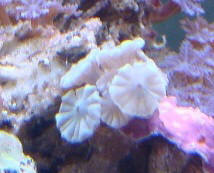 |
Re: Coral ID 09/29/09
Yeah that is looking right. Apparently the requirements are quite
difficult to meet but I will try my best with it. Thank you very
much for your help!
<Yes, they tend to be... but if this is a hitchhiker, I would
take that as a sign that it's a little hardier than
usual.>
Mark
<Best,
Sara M.> |
|
Porites ID -- 5/22/09
Hi all.
<Hi Debra>
Although there are many different Porites, I was hoping to see if
you could possibly suggest a species.
<Possibly Porites astreoides, P. lobata, P. lichen, or P.
lutea (known to be associated with Christmas tree worms -
Spirobranchus spp). I've seen beautiful pink and blue P.
lichen colonies in Eric Borneman's Aquarium Corals book (pg
245). I've also seen another listed as Mike Paletta's
Purple Porites on the 'net that supposedly turns a
bluish/purple under high lighting. Unfortunately, I don't
know which species that is. Differentiating Porites spp. can be
difficult because color and form can vary according to depth,
current, etc. It's something best done under magnification of
the corallites. For more information, please see the following
links:
http://www.wetwebmedia.com/porites.htm
The following site illustrates the differences between many
Porites species (including P. lutea and P. lobata):
Google books link>
A brief history and some observations. I purchased some rock from
someone breaking down their tank late 2007. They mentioned that
this rock had Christmas tree worms on it at one time.
<It's most likely a Porites spp, but there are other
possibilities as well. Please see the following link for more
candidates:
http://www.advancedaquarist.com/issues/sept2002/toonen.htm
>
The rock was at the bottom under many larger rocks (120 gal
aquarium). I put it in my NanoCube with Zoa collection as a base
rock. At some point I noticed some slight coloring and
"movement" on the rock and thought it was some sort of
algae. A closer look revealed polyps. I flipped it around so it
could get some light. The small section was about 3/4"
around. It has now covered the complete top of the 5-6 inch
diameter rock.
<Wow, is it ever beautiful!>
The coral was always brown under PC or 70W HQI with tiny polyps
extended and waving and fast growing. It was moved to an SPS tank
with T5 HO and it started to color up.
<Brown coloration could have been due to light/nutrient level
issues, or both.>
It went from brown to a sort of bluish/purple hue.
<Nice>
It appears very hardy. It has never changed growth rate despite
different water and lighting conditions. I've never
acclimated it from tank to tank. I picked up some weird nuisance
algae on a frag and the algae attached to the Porites rock.
<Hate it when that happens!>
Numerous times I took it out, scraped the rock clean, put it
back, never fazing the Porites.
<They can be tough that way. I've seen photos of exposed
Porites colonies at low tide. Apparently the routine exposure
causes no significant ill effects.>
I have another small Porites with Christmas tree worms on it and
from time to time it closes up to shed a mucous coat.
<Typical behavior>
I have never seen this Porites exhibit that behavior.
<Interesting>
It encrusts over rock (probably will encrust over anything) but
it also began encrusting out past the rock with no
support/attachment underneath.
<Plating growth -- neat>
I broke off those pieces and glued them onto a frag disk. In less
than two months time you can see the four distinct pieces in the
picture have already joined and are quickly covering the
disk.
<That's a very happy coral!>
Its growth appears to be smooth, with bumps and ridges formed due
to what it's covering. I'm unsure of its temperament but
I gather it's somewhat peaceful.
<Yes, Porites are one of the least aggressive corals out
there.>
Thanks in advance for your help.
<You're very welcome>
Here are some pics. Both samples are in different areas of the
tank thus the different coloring. It appears the higher the light
intensity the bluer it turns.
<Very pretty, indeed!>
Debbie Piedra
<Take care, LynnZ>
|
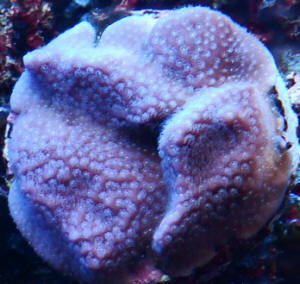 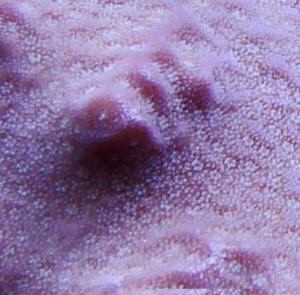 |
|
Coral Identification - Goniopora
3/19/2009
Hello.
<Hi there, Mich with you.>
Can you tell me what type of coral this is?
<Yes it is a Goniopora, commonly called a flowerpot coral, and
they typically don't do well in captivity as each and every
individual polyp needs to be fed, ie each of the little
"flowers". It is generally not a
coral that should be tried by a beginner. Please don't take
this the wrong way, but if you don't know the name, it is not
an animal you should be keeping. You should always know the care
requirements of any creature for which you assume responsibility
and if you don't know what it is, you are not likely to know
the animals care requirements. The animal is at your mercy. I
implore you to learn about the needs of any animal in your
custody. Not knowing is irresponsible. I am hoping you are in the
researching stage and this is a photo from the LFS, which is
where this coral should be left in my opinion. More here:
http://www.wetwebmedia.com/gonioporapix.htm >
I cannot find a picture of it anywhere to identify it.
<Hope this helped.>
Thanks.
<Welcome!>
|
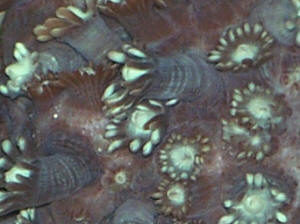 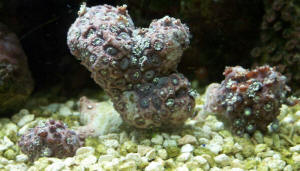 |
|
Coral ID 1/8/09 Hi Bob, <Hello Beta. Minh
at your service.> I have attached a pic of the coral that I
need an ID on. I don't much have info on the specimen as the
pic was sent to me by a friend. <I assume you are referring to
the brilliantly colored yellow encrusting hard coral in the right
center of the photograph, correct? At first glance, one could
pass this coral to be Porites sp. (perhaps Porites cylindrica).
However, upon closer inspection, the polyp size and extension in
comparison to the Turbinaria peltata on the lower left indicates
another coral from the genus Goniopora in the Poritidae family.
The size and extension of the polyps as well as the growth form
of this particular specimen resembles Goniopora stutchburyi.
However, the coloration of this specimen does not appear to be
natural and I'm afraid it could have been dyed.
Unfortunately, I have seen similar corals often imported to our
local fish stores in the states. More information about dyed
corals including a photo of a close matching specimen can be
found here:
http://www.reefkeeping.com/issues/2002-09/eb/index.php. Also,
more information about care of Goniopora stutchburyi can be found
in detail here:
http://www.advancedaquarist.com/2005/10/aafeature2/. I have been
researching Goniopora care for a few years now, so feel free to
write back with more information on identification or care of
this genus.> Regards Beta India <Good luck. Cheers, Minh
Huynh.>
|
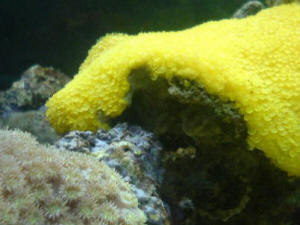 |
| Mystery Coral... reading... 3/6/08 Dear Crew,
I just purchased a coral from my LFS last week. They said it was a
green-eyed Goniopora, because that's how it was labeled at the
warehouse. <Mmm, does appear to be of this genus... perhaps
artificially dyed...> However, it looks nothing like a
Goniopora. <The pix are blurry, but do look at the individual
polyps, the corallites... and read here:
http://wetwebmedia.com/gonioporapix.htm> I have searched all
over the Internet and have been unable to find anything that
resembles it. The LFS said they'd take it back if it were
indeed a Goniopora sp. The coral has a hard skeleton and is LPS in
nature. <Please send along a better resolved, closer
image...> From the skeleton, very small fluorescent green polyps
(no more than 1 or 2 mm in diameter) extend no farther than a
couple of mm, under 65 watt compact fluorescent and 400 watt metal
halide lighting. I have the coral positioned away from the halide,
since I do not know how much light it needs and I do not want to
bleach it or stress it. The coral responded well to DT's
phytoplankton. <... see the above citations linked files
above... on Feeding...> The coral appears to be an encrusting
species. I have attached pictures. I hope they are clear enough for
you to see. I guess the glass and water in the aquarium diffracts
the light too much when I zoom in, because it always gets blurry.
<Is more likely limitation/s of the camera, lens...> Also,
around the base of the coral are some smooth, brown things. I
thought at first that they were a type of flat worm. but they
appear to be rather hard (firm may be a better word) and they do
not seem to be moving. Any thoughts? <Looks like inorganic
substrate/matrix...> You may be able to see them in the pics.
They seem to have three small dark dots that are slightly raised on
them. I removed one with a pair of tweezers. It had no noticeable
traits and it was firmly attached all the way to the base. Thank
y'all ahead of time for all that you do and your commitment to
the hobby. Thank you, Brolin Evans P.S. I want to thank Brenda and
let her know that my BTA is doing wonderfully after its incident
with the powerhead. It seems to have fully recovered. <Ah,
good... Read. Bob Fenner> |
|
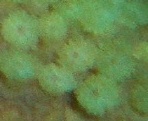 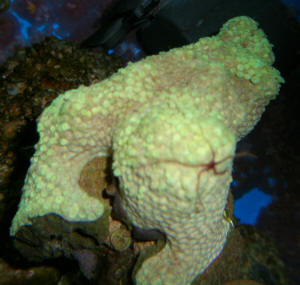
|
|
Re: Condylactis passiflora, intra species
contention?, and now Goniopora ID, feeding, sys. 7/13/07
Thanks very much for your enlightening response ;-) Have actually
spent literally years reading WetWebMedia FAQs and articles, was
merely struggling a bit with this one, in any case have
re-tackled the Alkalinity/Hardness/Ca issue and think I'm
pretty much across the concepts (if I'm not , then I suspect
I never will be). Have tested my water (PH 8.2, Salinity 1.025,
Nitrates >60ppm, no Nitrites or Ammonia, Temp 24C, Ca 340ppm,
dKH 12.5), and doesn't seem too bad. Regarding the possible
Condy contention below , should I move one of them out if I can
get the chance ( if they come out of the holes they have burrowed
into to)? <Yes, I would> Confession Time: The background
here is that a not so "funny thing happened the other
day", Bear in mind , I haven't devoted a lot of time to
the hobby over the last year, and my memory isn't so good, as
a result I have made a rather disastrous mistake: I was in the
LFS to buy a Sarcophyton I have had my eye on for a few weeks,
and while I was there they had a beautiful large Goniopora
(WAIT!, WAIT! please, stay with me.....just a bit longer) and
they only wanted $55 AUD for it . I said to the
"Expert" in charge of their marine section
"Isn't that the one that has the really dismal survival
rate in captivity?", ." Oh no, says Expert, these are
quite easy and this one has been doing really well " .
<Mmm, not so... this Genus IS the most used historically...
but also has the survival value adverb you suggest> I wander
the shop some more with my two year old son distracting me
heavily thinking "....or is that the other one beginning
with" Go", gogi.., gopi..something...?, and suddenly
remember "That's it! Gorgonian!, the Sea fan, it must be
that one that I was thinking of that I decided never to own.
<Mmm, well, some of those/these hexacorals are not
aquarium-hardy at all either...> Bought said victim, took home
looked at notes/bookmarks again , placed head in hands and came
to realisation that am probably developing Alzheimer's. <I
can't seem to remember...> After sobbing a bit decided to
do right thing and return it for a credit note, but ....LFS
won't take it back, and don't have any friends that do
Marine. I feel like such an idiot! I only didn't mention this
before because it's so embarrassing, Now I am stuck with it,
and desperately don't want to be responsible for killing it,
it is a beautifully healthy specimen. Have spent a full week of
hours per day researching ways to keep it alive (hampered by the
fact that I can't decide if it is a stokesi, columna or
lobata (Even though I majored in Animal Ecology at Uni 17 years
ago ... <See my cursory review of "The World Trade in
Coral" posted on WWM... species, even higher tax. ID's
of Scleractinia are not easy> like I said, my brain appears to
have fallen out). It is Hemispherical Colony on a single coned
shaped column (looks like they skeleton has basically grown out
and up in a circular fashion), Polyps are long and brown with
green tipped tentacles (attached pictures, - the leather is has
now been moved away from the Goni and I will keep a close eye on
the Condy's although they don't seem inclined to move
again, clown hasn't approached it) What do you think it might
be? <Am looking... Columns too long for the first... tentacles
not shaped like the second... I make this out to be the most
common aquarium species, G. stokesi> Now if you are still
reading , here's my questions : I have a bag of Seachem
Oolitic Aragonite , that I bought for several reasons , one
because my Nitrates keep creeping too fast (about 20-40ppm per
week in 100 litre tank) <The high/er NO3 is actually of use,
advised for this genus...> to be explained by my tiny stock
(two small/medium fish) and stingy feeding rates and frequent
(weekly) water changes, that I suspect that the 3 year old
crushed shell substrate may be harbouring to much bound organic
matter (even though I vacuum it vigorously) so I want to replace
it. <I would NOT do this... but possibly add to...> Two
because I was originally thinking to use it to help stabilise
Alkalinity and add Ca , and Three because I am hoping/Praying I
can foster some microfauna to help feed the Goni (do these 3
arguments sound plausible?). <Is, though a much larger system,
and really a separate, tied-in refugium with DSB, lighting... is
STRONGLY advised> Given that the water parameters above
don't seem too bad for Ca and KH considering that I have
never measured or attempted to alter either in 3 years , should I
leave the Aragonite out in case it messes with the balance? (no..
I can't fit a refugium to this tank (wife/children etc) ).
<I would leave in for the very organic component you
mention...> In terms of Feeding it , I am attempting a mix of
Hikari rotifer, baby shrimp and algae glass scraping, and
recently purchased some frozen blocks of Spirulina, octopus,
mussel, and shrimp mush to try as well (having trouble getting
Cyclop-eeze, do you think the freeze dried would be ok or should
I only go for the frozen if I can get it?). <All are suitable
if small enough to fit into individual polyps... I would develop
a routine of "covering" the colony temporarily,
immersing the polyps with food... while having mechanical
filtration suspended during these minutes... to assure each are
fed...> If I can impose on your patience just a little
longer... some Goni questions that I have read conflicting
arguments on : 1. Do they tolerate nitrate well or not, have read
conflicting assertions, I am guessing my typical reading of
around 40ppm may still be a bit high for it? <This genus lives
in quite "polluted" waters... including VERY high NO3
concentration> 2. Are baby shrimp small enough/suitable for
it? (these look about the same size as a rotifer), should I try
and culture some green water (phytoplankton) maybe? <Mmm,
don't eat phytoplankton to any appreciable degree... meaty
food items need to be "mouth size"... or smaller> 3.
Is it abnormal for it to close into a swollen ball for about 4
hours after the lights go out, it only seems to look really happy
during the day ( have read they should be out day and night), it
is only under 2 x 18W at the moment and seems quite happy and I
am about to add 75W 6500K for it, do you think it might actually
not like the brighter light ( it WAS under Halides in the shop)
<Not atypical behavior in both cases> 4. The LFS was
feeding it JBL Koralle Fluid and claims it loves it, all the
stock I can find on Melbourne shelves is out of date by a least 6
months!, most of the Red sea and Seachem alternatives I can find
here all list about 0.0003mg/g of copper in them, <Not to
worry re this preservative trace> (except for Red Sea Coral
Trace that I can't get any specs on at all and Marine trace
that just says the elements but no concentrations) and I am
worried this may accumulate and hurt my feather dusters and
corals, even though it isn't much, do you think Seachem Reef
Trace(0.0003mg/g Cu) or Reef Plus(0.001Mg.g Cu) might be a good
product for my Goni even with the copper? <Yes... no worries.
Some small amount of copper is actually necessary... a
"micro-nutrient"> I have to keep this guy alive in
this tank for around 10 months somehow until I can get my new 5
foot reef system up and running (house being built at the moment)
with refugium, Thalassia etc. <I'd move it last...> I
will keep researching , but would appreciate any pearls of wisdom
you could impart (besides " Research before you buy"
and."... keep reading" already know those ones ;-) )
Cheers,
Rama
<Heeee! BobF>
|
|
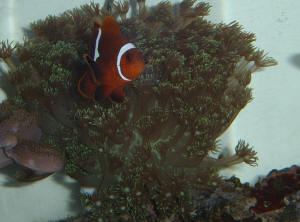 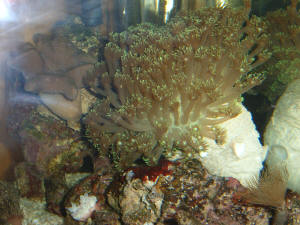
|
Id of this Coral... Alveopora 7/8/07 Hi,
<Hi Andrea, Mich here.> I have looked on the website posted
to groups and etc. Unfortunately I am still stumped on what type of
coral this is. <Is an Alveopora AKA daisy coral or flowerpot
coral. Is similar to Goniopora. Typically these corals are
challenging to keep and often do not do well in captivity. More
here: http://www.wetwebmedia.com/alveopora.htm
http://advancedaquarist.com/issues/dec2002/invert.htm
http://www.reefkeeping.com/issues/2005-10/nftt/index.php It came in
on a rock with another piece of coral I purchased. I have enclosed
a close up shot of it. <I see. A nice photo!> Thanks in
advance
Andrea |
|
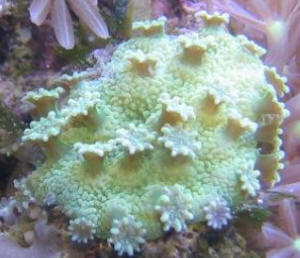
|
Coral I.D. Not Porites, but maybe Goniopora?
2/14/07 Good Evening Bob: <Nope, GrahamT here! (Happy
V-day.)> I am still hoping to identify the two little coral
colonies that I have been caring for these last 16 months.
<Let's see what we've got here...> It is sort of like
caring for an orphan and wishing to know of the child's
parents. <Hehe...> I hope that I am not asking too much,
<Never...>> but I wonder if you would mind comparing the
photograph of my little corals to the corals shown here http://whelk.aims.gov.au/coralsearch/html/601-700/Species%20pages/606.htm
. Is this a possible match? <No, I don't think so. The
corals pictured in your link are SPS, and while very attractive and
desirable, differ in at least a few ways from your picture. You
pic, though blurrily shot, shows large polyps, and no hint of the
underlying skeletal structure shape or size. I would think you have
a variety of Goniopora, but you can make the judgment better than I
by looking here, ( http://wetwebmedia.com/gonioporapix.htm ) and counting
your tentacles on each polyp.> Thanks as always for your
incredible Web-site and all that you do for us. <No, thank you.
Your questions are what make our answers possible.>
Sincerely,
Brad in Basalt
<-GrahamT> |
|
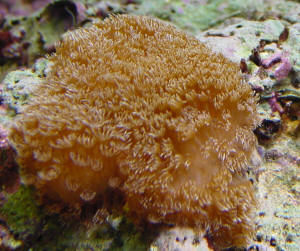
|
| Re: Identification Please... No photo...please
resend and now with Pic... SPS Possibly Porites? 1/19/07 Oops,
sorry for forgetting the picture. <It's OK, I'm guilty
of the same! Well, it looks like a SPS, small polyp stony coral, My
best guess is something in the Porites family. Keep doing what your
doing if you've had that much growth in short of period of
time. Generally, Porites like bright light, though many are pretty
tolerant in regards to light, turbidity and even salinity. Good
luck! -Mich> |
|
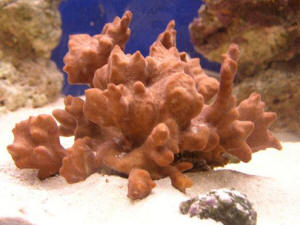
|
Stringy Stuff? - 04/12/06 WWM, <<Hello Mike...EricR
here>> I currently have an Alveopora in my tank and it seems to
be doing very well. When it retracts at night you can see the hard
encrusting base, what I call the skeleton. On some parts of the
skeleton I can see some white stringy stuff, which seems to expand and
contract at different times, but not at regular intervals. One day when
the Alveopora was completely expanded I could see the stringy stuff
hanging out the bottom. Haven't seen it like that ever since. At
the moment you can barely see the stingy stuff, it looks like white
streaks amongst the purple skeleton, until you get up close. My
question is "what is this stuff?" I have searched and
searched and have only found one link on Google that pertains to what I
am talking about but the link is bad, so here I am asking for your help
and wisdom. <<Hmmm, a picture would help...might be a species of
sponge...I have a "stringy" sponge in a purple variety that
populates low light areas in my tank, as well as amongst the
"stalks" of my Caulastrea. If it's limited to encrusting
the non-fleshy/hard surfaces it likely is nothing of concern>>
Thanks for you time, Mike <<Regards, EricR>>
Hard Lessons on Coral Keeping: Look before you leap, please!
Dear WWM Crew, <cheers, mate> Can you please take a look at the
attached picture of my new tankmate. <thanks kindly. It is clearly a
Goniopora species. Very difficult if possible for any beginner to keep.
Actually, its extremely difficult for advanced aquarists to keep too.
Most die within weeks of import. This one will almost certainly not
live to see a year captive at any rate unless you make rapid changes in
system design or get it to someone that has a better shot at keeping
it. Shame on your dealer for selling it to you without advising you of
its needs, and quite frankly bud... you need to shoulder the same blame
for buying a living creature without knowing its needs and if you could
meet them first. It will likely cost this animal its life> I am
trying to identify him and to get more info on habits, lighting,
feeding, etc. to keep him happy. <please use the genus name
"Goniopora" to do a keyword search in our wetwebmedia.com
archives (use the Google search tool on the home page). There are many
FAQs regarding this creature. I will also say that the animal CAN
indeed be kept... but not likely the way you want to keep it. It needs
deep sand bed systems (perhaps 6" plus) that are mature and have
been established for some time to generate natural plankton. Seagrasses
kept in-line in a fishless refugium may also be extremely helpful for
producing phyto and epiphytic matter. It will benefit by being kept on
the sand bottom in a colony with others of its kind... but will likely
suffer in time in a mixed "reef aquarium" packed with a
variety of species conducting silent chemical warfare on each other
(allelopathy). You are going to learn a hard lesson on this coral most
likely and I do hope that you will be sure to not only research an
animals need before you bring it home... but also be sure to quarantine
it. Again, please browse our archives where there are many thousands of
pages that should interest you (like QT articles by Fellman). Be
mindful too of infection with this coral. The brown jelly infection
that commonly afflicts Goniopora as they begin to die can wipe out
many/any of your other healthy corals in the display> Also, maybe
how it breeds, <I have had this coral propagate naturally by issuing
daughter satellites in modified tentacles that form an incused
calcareous nodule which tears away from the parent to become
free-living in time. Reproduction by fragmentation or sexually produced
planulae is unlikely here> and if it is a risk to any other type of
animal. Most importantly what should I feed him? <this coral cannot
eat anything prepared (from a bottle, bag, pack, etc) that you can
offer it... needs natural nanoplankton from a fishless refugium in
aquaristics. Research refugium methodologies too. Dude... you really
could not have picked a worse coral to buy on impulse... I regret to
say. I do wish the best of luck to you though.> Thank you in
advance! Martin <Anthony>
Goniopora? - 3/28/03 Hi WWM experts! <Hi. Paul here> I
have been reading many of your articles, and they are absolutely
helpful and useful! <Thank you very much. So many hard at work for
our readership, it's nice to be recognized> But I do have one
simple question, I recently bought this coral...<Uh oh.......looks
like someone needs to look a little before buying a coral, eh? =) Also
an even better idea, seriously though, is to purchase a book to help
with identification and self education. (never know when you will be
asked about a coral) I like Eric Borneman's books and Anthony
Calfo's book very much. Do a search on Amazon and look into
purchasing them. Anyway, the coral looks to be a Goniopora. See here:
http://www.wetwebmedia.com/gonioporapix.htm>
but I have no idea what it is? <See previous statement. A good
policy is to look before leaping not only for your pocket book's
sake but also the life you hold in your care. I had to say this to you,
please don't take it personally. I am just doing my duty as a
Conscientious Marine Aquarist. >Thanks in advance! <My pleasure,
I do appreciate you coming to this forum for help and hope you will
continue to do so. Knowledge is half the battle, my friend. You are
well on your way. Cheers, Paul>
| Goniopora Hi guys, Can you tell me what
this coral is called ? I want to learn more about this, definitely
don't want it to die. Thanks! <... unfortunately this is a
Goniopora, Flower Pot Coral... one of the most notoriously poor
candidates (easily dies) for marine aquarium keeping. Please read
here re: http://www.wetwebmedia.com/gonioporapix.htm
on to the Related FAQs (linked, in blue, at top)... and PLEASE
investigate BEFORE purchasing all livestock. Bob Fenner> |
|
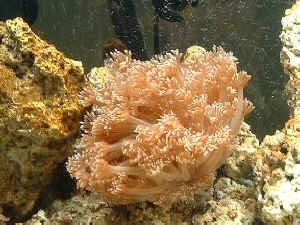
|
| RE: Help with a coral thank you, you guys
are definitely the greatest ! <Hmm, I thought that was Muhammad
Ali? You're welcome. Bob Fenner> |
Alveopora? or not? Count the tentacles 2/18/04 Hi Crew, I was
wondering how I could tell the differences between a red Alveopora and
a red Goniopora <Alveopora has 12 tentacles per polyp... Goniopora
has 24> because a LFS has a coral marked as a red Alveopora but I
think its a red Goniopora because I have never seen a red Alveopora
before. <heehee... that's an odd sort of logic? It doesn't
exist because you've never seen one before :p You're killing me
here!> I don't want to be trick into getting a difficult coral
to care for. <neither is easy... and Alveopora still requires an
advanced/specialized care... perhaps do resist. Maybe buy a good book
instead... seriously, to help you get better informed and prepared for
such corals in the future. Do consider Eric Borneman's
"Aquarium Corals" - he describes the difference between these
corals in there too ;)> Also if it could be an Alveopora is there
any special requirements for it while it is in QT <careful
acclimation to light as with all corals... and preparedness to
use/employ a refugium to provide food. Else do not buy the coral IMO.
Anthony>
Re: Please help identify. (Goniopora) Dear
WWM Crew, Can you please take a look at the attached picture of my
new tankmate. I am trying to identify him and to get more info on
habits, lighting, feeding, etc. to keep him happy. Also, maybe how
it breeds, and if it is a risk to any other type of animal. Most
importantly what should I feed him? <Umm, sorry to inform you,
this is the all-time easily lost Flowerpot Coral, Goniopora. Please
see here re: http://www.wetwebmedia.com/poritidfaqs.htm
and the linked FAQs and articles on the genus, family (in blue,
above) beyond. Next time... study before you buy. Bob Fenner>
Thank you in advance!
Martin |
|
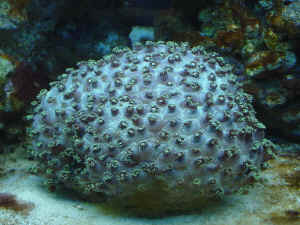
|
|
|

